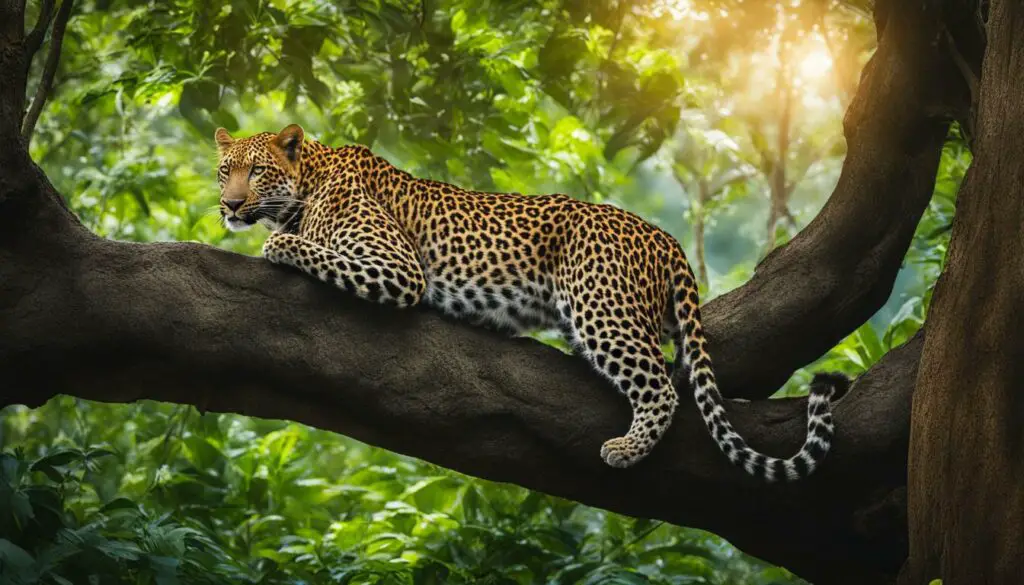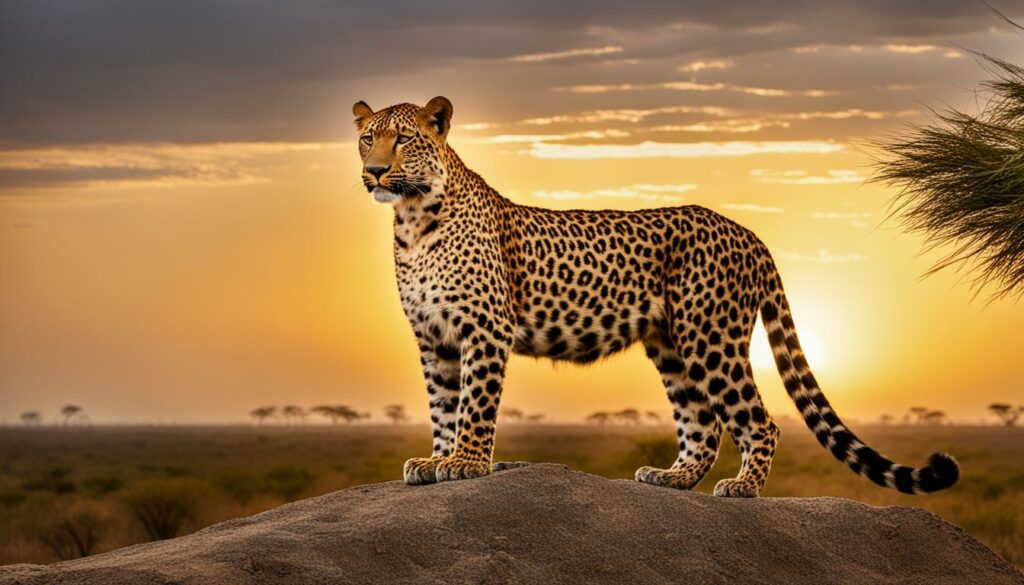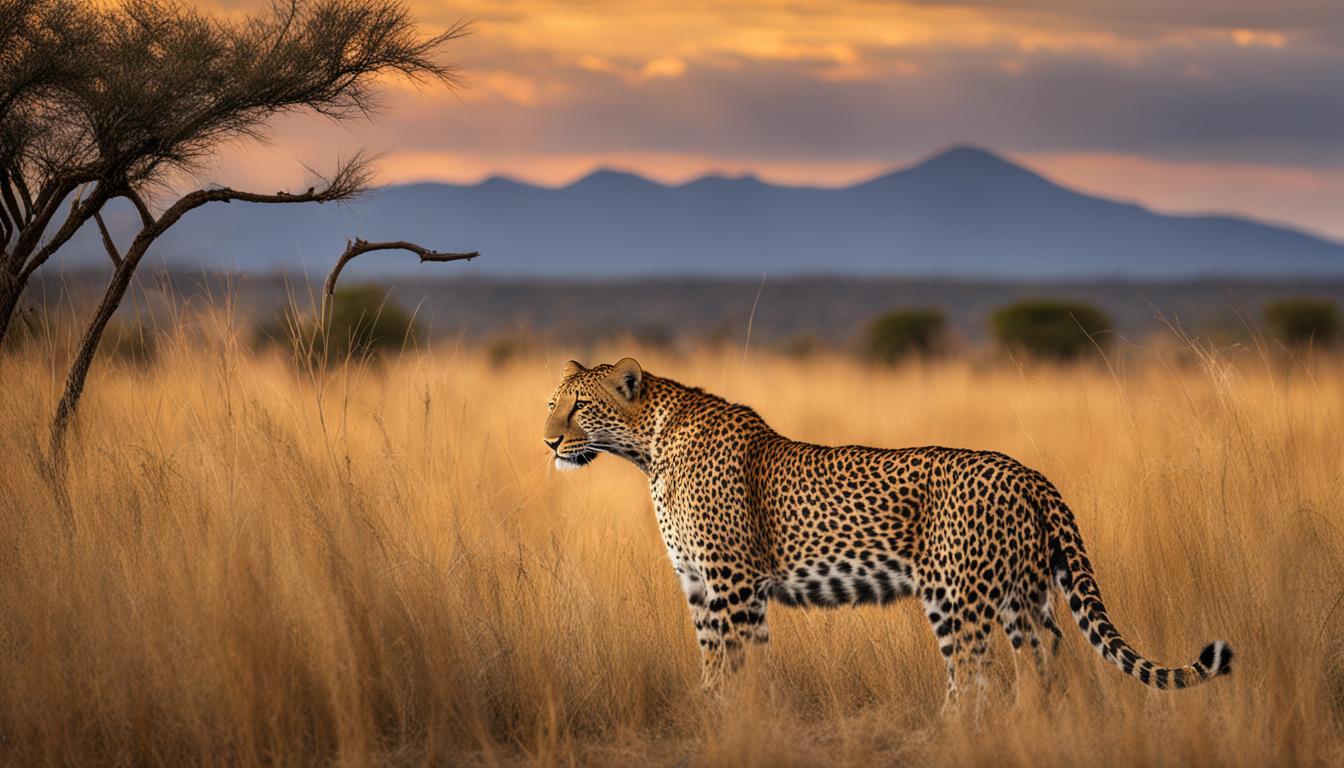Welcome to our exploration of the fascinating world of leopards! In this section, we will delve into their natural environment, their geographical range, and the conditions they need to thrive. Join us as we take a closer look at the leopard habitat, preservation efforts, and the challenges they face in their ever-changing ecosystem.
Size, Appearance, and Diet of Leopards
Leopards are fascinating creatures with unique characteristics that set them apart from other big cat species. Let’s delve into their size, appearance, and diet to gain a better understanding of these majestic animals.
Size and Weight
Leopards are the smallest of the large cat species, with males weighing between 80 to 165 pounds and females weighing between 46 to 132 pounds. They have a shoulder height ranging from 17.5 to 30.5 inches, making them agile and nimble hunters in their natural habitats.
Coat and Spots
The beauty of a leopard lies in its distinctive coat, which varies depending on the subspecies and the habitat it inhabits. The colors of their coat range from tawny or light yellow to a darker reddish-orange. The coat is adorned with dark spots called rosettes, circular in eastern African leopards and square in southern African leopards, lending them an exquisite and mesmerizing appearance.
Diet
Leopards are carnivores and possess a varied diet that reflects their adaptability. They feed on ungulates such as antelopes, deer, and wild pigs. However, their diet is not limited to land-dwelling animals; they also hunt primates, rodents, fish, and even dung beetles. Their hunting prowess and agility allow them to effectively carry their prey up into trees to avoid losing it to other predators or scavengers.
To summarize, leopards possess a unique combination of size, appearance, and dietary habits that make them one of the most fascinating big cat species in the world.
“The beauty of a leopard lies in its distinctive coat, which varies depending on the subspecies and the habitat it inhabits.”
Behavior and Social Structure of Leopards
Leopards are fascinating creatures known for their unique behaviors and social structures. Understanding their behavior is crucial for appreciating their role in the ecosystem and taking appropriate conservation measures.
When it comes to hunting, leopards are skilled and versatile predators. They have an agile and stealthy nature, allowing them to ambush their prey effectively. Their hunting techniques involve stalking, pouncing, and suffocating their prey with a bite to the throat. Leopards have a diverse diet that includes ungulates, such as deer and antelope, as well as smaller mammals, birds, and even fish. This adaptability in hunting strategies and diet contributes to their survival in various habitats.
Leopards are also excellent climbers and often carry their prey into trees to avoid competition from other predators such as lions or hyenas. Their climbing abilities allow them to escape danger, rest, and even store carcasses for future consumption. In addition to climbing, leopards are surprisingly adept swimmers. They can swim long distances, making them one of the few cat species comfortable in water.
Leopards mark their territories through urine spraying and claw marks on trees. These territorial markings communicate their presence to other leopards and help to avoid conflicts. However, if territories overlap, leopards may engage in fierce fights to defend their space.
Table: Comparative Traits of Different Leopard Subspecies
| Subspecies | Behavior | Habitat |
|---|---|---|
| African Leopard | Solitary, territorial | Wide range of habitats, including forests, savannas, and grasslands |
| Snow Leopard | Solitary, elusive | Mountainous regions, above the tree line |
| Clouded Leopard | Secretive, arboreal | Tropical and subtropical forests |
Leopards are generally solitary animals, with limited interactions between individuals except during mating or when raising cubs. The male leopard’s territory often overlaps with multiple female territories, allowing for potential mating opportunities. Female leopards give birth to a litter of usually two to three cubs, which they raise on their own. The cubs stay with their mother until they reach independence, learning essential hunting and survival skills from her.
Understanding the behavior and social structure of leopards is crucial for their conservation. By conserving their habitats and protecting their populations, we can ensure the continued existence of these magnificent creatures.

Breeding and Lifecycle of Leopards
Leopards have a fascinating breeding and lifecycle that contributes to the perpetuation of their species. Understanding these aspects is essential in preserving their populations and ensuring their long-term survival in the wild.
Female leopards reach sexual maturity around two to three years of age, while males become sexually mature slightly later. During the breeding season, male leopards use scent markers to locate receptive females. Once a male and female pair, they engage in courtship behavior that includes vocalizations and physical interaction.
The gestation period for leopards is approximately three months. Female leopards give birth to a litter of usually two to three cubs. The cubs are born vulnerable, with sealed eyes and little hair. The mother takes care of the cubs, providing them with milk and keeping them in a den until they are ready to venture out. This maternal care is crucial for the cubs’ survival and development.
Cubs learn hunting and survival skills from their mother, gradually accompanying her on hunting expeditions. They typically stay with their mother until they are around 12 to 18 months old, after which they become independent and start their own solitary lives. Leopards reach sexual maturity between two to three years of age, marking the beginning of the next generation.
Leopard Breeding and Lifecycle:
| Stage | Description |
|---|---|
| Sexual Maturity | Female leopards: 2-3 years; Male leopards: slightly later |
| Breeding Season | Males use scent markers to locate receptive females |
| Courtship | Vocalizations and physical interaction between the male and female |
| Gestation Period | Approximately three months |
| Birth | Females give birth to a litter of usually 2-3 cubs |
| Maternal Care | Mother provides milk and keeps the cubs in a den |
| Skills Development | Cubs learn hunting and survival skills from their mother |
| Independence | Cubs become independent around 12-18 months old |
| Sexual Maturity | Leopards reach sexual maturity between 2-3 years of age |
Understanding the breeding and lifecycle of leopards allows us to appreciate their complex social structure and the role of maternal care in shaping the next generation of these magnificent creatures.
Threats to Leopard Population
Leopards face numerous threats that endanger their population and habitat. One significant threat is habitat loss, primarily due to urban expansion and deforestation. As human populations grow and expand into natural areas, leopard habitats are being destroyed or fragmented, limiting their access to food sources and safe territories. This loss of habitat poses a severe risk to leopard populations, making conservation efforts crucial in safeguarding their survival.
Another threat to leopards is hunting and poaching. Leopards are often targeted and killed for their beautiful fur, which is highly valued in the illegal wildlife trade. Additionally, leopards may be hunted or trapped by humans who perceive them as a threat to livestock or human safety. These human-wildlife conflicts often result in the death of leopards, further impacting their population numbers.
“The leopard population is facing a significant decline due to habitat loss and human activities, such as hunting and poaching,” explains Dr. Jane Wilson, a wildlife conservation expert. “Conservation efforts must focus on protecting their habitats and reducing conflicts between humans and leopards to ensure their long-term survival.”
| Threat | Impact |
|---|---|
| Habitat Loss | Reduces food sources and safe territories, leading to population decline. |
| Hunting and Poaching | Leopards are killed for their fur and seen as a threat to livestock, resulting in human-wildlife conflicts. |
| Human-Wildlife Conflict | Leopards may be targeted by humans due to perceived threats, leading to retaliatory killings and further endangering the population. |
To address these threats, it is crucial to implement measures for habitat conservation and actively promote coexistence between humans and leopards. This includes establishing protected areas and wildlife corridors to preserve leopard habitats, enacting and enforcing wildlife protection laws, and raising awareness among local communities about the importance of leopard conservation. By taking these actions, we can help protect the magnificent leopards and ensure their survival in the wild.
Conservation of Leopard Habitat
Protecting the habitat of leopards is crucial for their long-term survival. Conservation efforts aim to address the threats faced by leopards and ensure their habitats are preserved. Monitoring the leopard population is an essential part of these conservation initiatives. By closely tracking population trends, scientists and researchers can gather valuable data that helps inform conservation strategies.
Conservation laws play a vital role in protecting leopards and their habitats. For example, the U.S. Endangered Species Act provides legal protection for endangered species like leopards, making it illegal to harm or trade them. These laws help deter poaching and other illegal activities that pose a threat to leopard populations.
Leopard Population Monitoring
One effective method used in leopard conservation is population monitoring. Researchers utilize various techniques, such as camera traps and field surveys, to estimate leopard numbers and assess the health of their populations. These monitoring efforts provide valuable insights into the distribution patterns, population density, and behavior of leopards.
The information gathered through population monitoring helps conservationists identify areas that require immediate attention and prioritize conservation efforts accordingly. It also helps measure the effectiveness of conservation programs over time and allows for adjustments to be made if necessary.
Leopard Conservation Laws
Conservation laws not only protect leopards but also regulate their trade and commercial exploitation. These laws prohibit the hunting, capturing, and trading of leopards and their body parts. They also ensure that any activities that may impact leopard habitats undergo thorough assessment and require proper permits.
Strong enforcement of conservation laws is crucial for effectively curbing activities that threaten leopard populations. Through the implementation of strict penalties and robust monitoring systems, governments and conservation organizations can deter illegal practices and ensure that leopards are safeguarded for future generations.
Leopard Habitat Preservation
Preserving leopard habitats is a key focus of conservation efforts. This involves protecting and restoring ecosystems that are essential for the survival of leopards. Initiatives such as creating protected areas, establishing wildlife corridors, and promoting sustainable land use practices help conserve leopard habitats.
Collaboration with local communities is also vital for successful habitat preservation. By engaging communities in conservation efforts, raising awareness about the importance of leopard habitats, and providing alternative livelihood options, conservationists can foster a sense of stewardship among local residents and promote sustainable coexistence between humans and leopards.

Conclusion
Leopards have a wide geographical range and can adapt to various habitats. From the forests of Africa to the mountainous regions of Asia, these majestic creatures have found a way to thrive in diverse environments. However, their habitat is under threat due to human activity. Habitat loss caused by urban expansion and poaching are endangering leopard populations worldwide.
Conservation efforts are essential to protect these beautiful and elusive creatures. By supporting conservation initiatives, we can play a vital role in preserving leopard populations and their habitats. From monitoring and studying leopard populations to implementing conservation laws, various measures are being taken to safeguard their future.
It is crucial that we raise awareness about the importance of leopard conservation. By educating local communities and promoting sustainable practices, we can reduce human-wildlife conflict and ensure a harmonious coexistence. The preservation of leopard habitat is not only crucial for their survival but also for the health and balance of the ecosystems they inhabit.
Together, we can contribute to the preservation of these magnificent creatures for future generations to admire and appreciate. By supporting conservation efforts, we are not only protecting leopards but also the rich biodiversity of our planet. Let us join hands in safeguarding their habitats and securing a bright future for these remarkable animals.
Can leopards be found in areas where they have natural predators?
Leopards can be found in areas where they have natural predators. While they are apex predators, they may still face threats from other powerful animals in their habitat. The natural predators of leopards, such as lions and hyenas, pose a risk to their survival, especially when it comes to competition for food and territory.
FAQ
Where can leopards be found in the wild?
Leopards have a wide geographical range and can be found in Africa, parts of the Middle East, and Asia, including China, India, and eastern Russia.
What is the size, appearance, and diet of leopards?
Leopards are the smallest of the large cats, with males weighing between 80 to 165 pounds and females weighing between 46 to 132 pounds. They have a shoulder height ranging from 17.5 to 30.5 inches. Their coat can range from tawny or light yellow to a darker reddish-orange, and they have dark spots called rosettes. Leopards are carnivores and have a varied diet that includes ungulates, primates, rodents, fish, and even dung beetles.
What is the behavior and social structure of leopards?
Leopards are solitary animals and tend to have limited interactions with other leopards, except during mating or when raising cubs. They are skilled hunters, mainly active at night, and known for their climbing ability. Leopards can also swim and mark their territory with urine and claw marks.
How do leopards breed and what is their lifecycle?
Male leopards use scent markers to find females during the breeding season. The gestation period for leopards is approximately three months, and females give birth to a litter of usually two to three cubs. The cubs are born vulnerable and rely on their mother for care and milk until they are ready to venture out. Cubs stay with their mother for around 12 to 18 months and reach sexual maturity around two to three years of age.
What are the threats to leopard populations?
Leopards face threats from habitat loss due to urban expansion, hunting for their fur and body parts, and conflict with farmers who view them as a threat to their livestock. They may also be killed by larger predators such as lions and hyenas.
How is leopard habitat being conserved?
Numerous conservation groups, wildlife parks, and conservation laws are working to protect leopards and their habitats. Scientists and researchers use various methods to monitor and study leopard populations. Conservation laws aim to protect these endangered species, and efforts are made to raise awareness among local communities about the importance of leopard conservation.
Why is leopard conservation important?
Leopards have a wide geographical range and can adapt to various habitats. However, their habitat is under threat due to human activity, including habitat loss and poaching. Conservation efforts are essential to protect leopard populations and their habitats. By supporting conservation initiatives, we can contribute to the preservation of these beautiful and elusive creatures for future generations to admire and appreciate.











